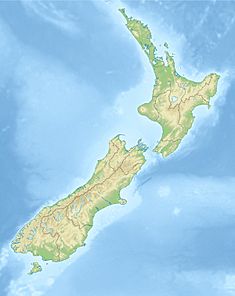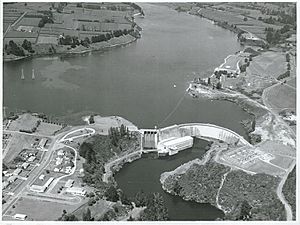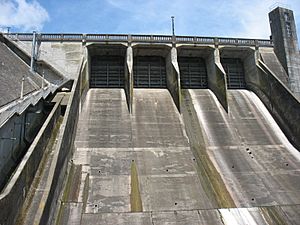Karāpiro Power Station facts for kids
Quick facts for kids Karāpiro Power Station |
|
|---|---|

Part of the Karāpiro Dam
|
|
|
Location of Karāpiro Power Station in New Zealand
|
|
| Country | New Zealand |
| Location | Near Cambridge, Waikato |
| Coordinates | 37°55′26″S 175°32′21″E / 37.92389°S 175.53917°E |
| Status | Operational |
| Construction began | 1940 |
| Opening date | May 1948 |
| Owner(s) | Mercury Energy |
| Dam and spillways | |
| Type of dam | Arch dam |
| Impounds | Waikato River |
| Height | 52.4 m (172 ft) |
| Length | 335 m (1,099 ft) |
| Width (crest) | 2.4 m (7 ft 10 in) |
| Width (base) | 15.2 m (50 ft) |
| Spillways | Four |
| Reservoir | |
| Creates | Lake Karapiro |
| Surface area | 7.7 km2 (3.0 sq mi) |
| Maximum water depth | 30.5 m (100 ft) |
| Power station | |
| Type | Conventional |
| Hydraulic head | 30 m (98 ft) |
| Turbines | 3 × Kaplan |
| Installed capacity | 112.5 MW |
| Annual generation | 537 GWh |
The Karāpiro Power Station is a hydroelectric power station in New Zealand. It is located on Lake Karapiro in the North Island. This station is the last of eight power stations on the Waikato River. It sits about 30 kilometers south-east of Hamilton. It is also about 9 kilometers from Cambridge.
Karāpiro is a "baseload" power station. This means it must always run to keep water flowing in the Waikato River. It operates even when there is not much water coming in. It also runs when people don't need much electricity. Two turbines usually keep the river flowing well. The third turbine is used when more power is needed. It is also used when other turbines are being fixed. Like all Waikato River power stations, Karāpiro is run by Mercury Energy.
Contents
History of Karāpiro Power Station
Karāpiro was the second power station built on the Waikato River. The first was Arapuni. Building the dam and power station started in 1940. However, World War II caused delays. There was not enough material or workers. The station was finished in 1947, four years later than planned.
Flooding the Horahora Power Station
When Lake Karapiro was created, it flooded an older power station. This station was called Horahora Power Station. It was the very first power station on the Waikato River. The first generator at Karāpiro started on April 10, 1947. This was just six days after Horahora was flooded. But there were some problems at first. Full power generation did not begin until April 21, 1947.
Generators and Power Output
The second generator started working on September 21, 1947. In its first year, the station made a lot of electricity. It produced over 349,568 megawatt-hours. This was more than 20 percent of all the electricity needed in the North Island. The third and final generator began operating in May 1948.
Upgrades and Improvements
The bridge over the spillway is the only road to the turbine hall. The first bridge had a support in the middle. This bridge was destroyed by floodwaters. The new bridge you see today has no central support.
Next to the four spillway gates are three siphon tubes. These were meant to control the lake level. The spillway gates were only for very big floods. But the siphon tubes did not work well. They were supposed to stop water flow with a blast of air. This never worked right. So, the spillway gates had to be used for daily lake control.
In 2019, Mercury Energy announced a big upgrade. Between 2022 and 2025, all three original turbines and generators were replaced. The power output increased from 96 megawatts (MW) to 112.5 MW. The amount of energy produced each year also went up. It increased from 505 gigawatt-hours (GWh) to 537 GWh.
How Karāpiro Makes Electricity
Karāpiro's powerhouse is on the northern side of the river. There is also a tunnel and a spillway on this side. A large concrete arch dam holds back the river behind the powerhouse. The electricity substation is on the southern side of the river.
Water from Lake Karapiro flows through large pipes called penstocks. These pipes lead to three special Kaplan turbines. Each turbine powers a generator. Each generator can make up to 37.5 MW of power at 11,000 volts. About 3,770 liters of water must pass through the turbines every second to make 1 MW of power.
Mercury Energy's control room in Hamilton manages Karāpiro. This means it can be controlled from far away.
Sending Out the Power
When the power station was built, a special power line was also made. This 110,000-volt line goes from Karāpiro to the Hamilton substation. It started working on March 29, 1947. This line is still used today. It is the main way Karāpiro connects to New Zealand's power grid.
Other 110,000-volt lines also connect Karāpiro. These lines go to Te Awamutu and Hinuera substations. These power lines are owned and run by Transpower. Transpower is the company that manages the national power grid.
See also
- Electricity sector in New Zealand
- List of power stations in New Zealand




